Red mangrove, Large-fruited orange mangrove
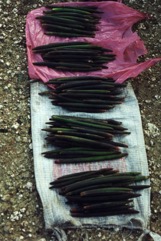
A tropical plant. They occur in mangrove swamps throughout the Philippines, and Asian and Pacific countries. It occurs in mangrove swamps but in the driest, best aerated soil. It can tolerate brackish or salt water flooded by high tide. It normally grows between sea level and 2 m altitude. It does best with temperatures between 20-30°C. It grows in acid to neutral soils with a pH between 4 and 7.4. It can grow in arid places.
Also known as:
Aongo, Betut, Biiu, Bodu kandoo, Burma mangrove, Busaing, Denges, Dogo, Dogo-kana, Dogo salusalu, Dogo tagane, Etam, Etum, Fago, Fogo, Jon, Kandeka, Kankara, Kankra, Kekra, Khoa, Ko'a ania, Koa kini, Large-leaved Mangrove, Mangle machu, M'tumansi, Mchofi, Mkifu, Mshinzi, Muia, Ong, Pang ka hua sum, Pasak, Petu, Rasinia, Sigapukokandam, Sohmw, Sraol, Tangampoly, Tango, Tanjung, Te buangi, Thuddaponna, Tiotsa, Tiri, Tiri wai, Togo, Tongo, Tumbus, Tumu merah, Tumu, Tumus, Vet du
Synonyms
- Rhizophora gymnorrhiza L.
- Bruguiera conjugata (L.) Merr.
- Bruguiera australis Arn.
- Bruguiera capensis Blume
- Bruguiera cylindrica (non Blume) Hance
- Bruguiera eriopetala W. & Arn.
- Bruguiera reedii Blume
- Rhizophora conjugata L.
- Rhizophora australis (Arn.) Steud.
Edible Portion
- Fruit, Leaves, Roots
Where does Red mangrove grow?
Found in: Africa, American Samoa, Andamans, Asia, Australia, Bangladesh, Bougainville, Brunei, Cambodia, Caroline Islands, China, Christmas Island, Chuuk, East Africa, East Timor, Ethiopia, Fiji, FSM, Guam, Hawaii, India, Indochina, Indonesia, Japan, Kenya, Kiribati, Madagascar, Malaysia, Maldives, Marshall Islands, Micronesia, Mozambique, Myanmar, Nauru, New Caledonia, Pacific, Pakistan, Palau, Papua New Guinea, PNG, Philippines, Rotuma, Ryukyu, Samoa, SE Asia, Seychelles, Solomon Islands, South Africa, Southern Africa, Sri Lanka, Taiwan, Tanzania, Thailand, Timor-Leste, Tonga, Vanuatu, Vietnam, Wallis and Futuna, Yap
Notes: There are 6 Bruguiera species. They grow in tropical mangrove swamps.
Status: In Australia the fruit are now rarely used but in the Solomon Islands these fruit are becoming a more popular item for sale and cooking. It is important in some small Pacific Islands.
Growing Red mangrove, Large-fruited orange mangrove
Cultivation: It grows wild. Seeds normally germinate and sprout while still attached to the tree. These seeds or seedlings can be planted or transplanted. They are simply stuck into the mud.
Edible Uses: The fruit are boiled twice in water, the outer covering being removed between the cookings. The starchy fruit are then eaten. Young leaves may be eaten, cooked. The timber is a good fuel but corrodes metal while burning.
Production: It is a slow growing tree. Flowering is from March to April in the Northern hemisphere and May to November in the southern hemisphere. Fruiting is in the following 2 months. Flowers and fruit can also occur throughout the year. Seeds can keep their germination ability for 5 to 6 months. Because the fruit contain tannin the fruit need to be grated then washed and rinsed before being cooked in coconut milk to give flavour.
Nutrition Info
per 100g edible portion| Edible Part | Energy (kcal) | Protein (g) | Iron (mg) | Vitamin A (ug) | Vitamin c (mg) | Zinc (mg) | % Water |
|---|---|---|---|---|---|---|---|
| Fruit | - | 2.2 | 1.2 | - | - | 0.5 | 64 |
| Leaves | - | - | - | - | - | - |
Red mangrove, Large-fruited orange mangrove Photos

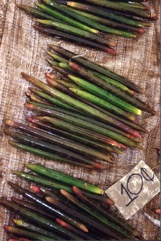
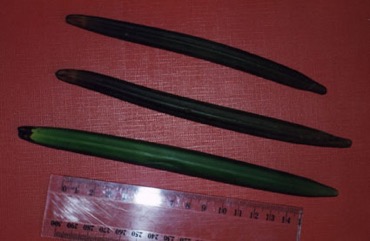
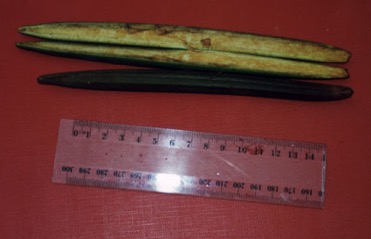
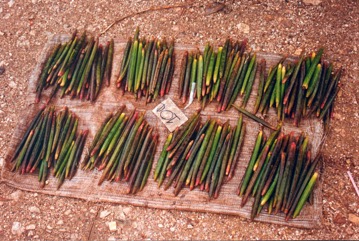
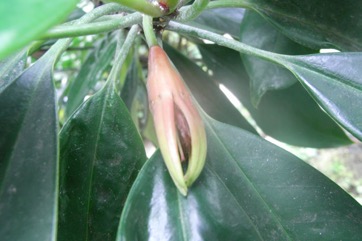
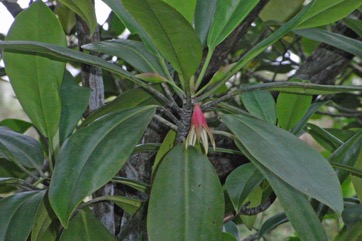
References
Ambasta S.P. (Ed.), 2000, The Useful Plants of India. CSIR India. p 88
Argent, G et al, nd, Manual of the Larger and More important non Dipterocarp Trees of Central Kalimantan Indonesia. Volume 2 Forest Research Institute, Samarinda, Indonesia. p 523
Awasthi, A.K., 1991, Ethnobotanical studies of the Negrito Islanders of Andaman Islands, India - The Great Andamanese. Economic Botany 45(2) pp274-280.
Barrau, J., 1976, Subsistence Agriculture in Melanesia. Bernice P. Bishop Museu, Bulletin 219 Honolulu Hawaii. Kraus reprint. p 17, 53 (As Bruguiera eriopetala)
Bircher, A. G. & Bircher, W. H., 2000, Encyclopedia of Fruit Trees and Edible Flowering Plants in Egypt and the Subtropics. AUC Press. p 67 (As Bruguiera conjugata)
Brock, J., 1993, Native Plants of Northern Australia, Reed. p 103
Burkill, I.H., 1966, A Dictionary of the Economic Products of the Malay Peninsula. Ministry of Agriculture and Cooperatives, Kuala Lumpur, Malaysia. Vol 1 (A-H) p 376 (As Bruguiera conjugata)
Castillo, C., 2013, The Archaeobotany of Khao Sam Kaeo and Phu Khao Thong: The Agriculture of Late Prehistoric Southern Thailand. Ph. D. thesis University College, London p 379
Cherikoff V. & Isaacs, J., The Bush Food Handbook. How to gather, grow, process and cook Australian Wild Foods. Ti Tree Press, Australia p 198
Clarke, W.C. & Thaman, R.R.(Eds.), 1993, Agroforestry in the Pacific Islands: Systems for sustainability. United Nations University Press. New York. p 225
Cooper, W. and Cooper, W., 2004, Fruits of the Australian Tropical Rainforest. Nokomis Editions, Victoria, Australia. p 427
Cribb, A.B. & J.W., 1976, Wild Food in Australia, Fontana. p 81
Cronin, L., 1989, The Concise Australian Flora. Reed. p 148
L. A. J. Desrousseaux et al., Encycl. 4:696. 1798
Dharani, N., 2002, Field Guide to common Trees & Shrubs of East Africa. Struik. p 300
Ding Hou, 1958, Rhizophoraceae in Flora Malesiana 5(4) p 461
Dobriyal, M. J. R. & Dobriyal, R., 2014, Non Wood Forest Produce an Option for Ethnic Food and Nutritional Security in India. Int. J. of Usuf. Mngt. 15(1):17-37
Elevitch, C.R.(ed.), 2006, Traditional Trees of the Pacific Islands: Their Culture, Environment and Use. Permanent Agriculture Resources, Holualoa, Hawaii. p 139
Elliot, W.R., & Jones, D.L., 1982, Encyclopedia of Australian Plants suitable for cultivation. Vol 2. Lothian. p 383
Fell, D.G. & Stanton, D.J., 2015: The vegetation and flora of Mabuyag, Torres Strait, Queensland. Memoirs of the Queensland Museum – Culture 8(1):1-33. Brisbane. ISSN 1440-4788.
Floyd, A.G., 1977, Ecology of the Tidal Forests in the Kikori-Romilly Sound Area Gulf of Papua. Ecology Report No 4 Division of Botany, Lae, Papua New Guinea. p 28
Forest Inventory and Planning Institute, 1996, Vietnam Forest Trees. Agriculture Publishing House p 598
Franklin, J., Keppel, G., & Whistler, W., 2008, The vegetation and flora of Lakeba, Nayau and Aiwa Islands, Central Lau Group, Fiji. Micronesica 40(1/2): 169–225, 2008
French, B.R., 2010, Food Plants of Solomon Islands. A Compendium. Food Plants International Inc. p 301
Frodin, D.G. & Leach, G.L., 1982, Mangroves of the Port Moresby Region. Biology Department Occasional Paper No 3 Revised edition. Papua New Guinea, p 30
Furusawa, T., et al, 2014, Interaction between forest biodiversity and people's used of forest resources in Roviana, Solomon Islands: implications for biocultural conservation under socioeconomic changes. Journal of Ethnobiology and Ethnomedicine, 10:10
GTZ 1996, A Guide to some Indigenous Fijian Trees. GTZ Suva. p 81
Haslam, S., 2004, Noosa's Native Plants. Noosa Integrated Catchment Assn. Inc. p 126
Havel, J.J., 1975, Forest Botany, Volume 3 Part 2 Botanical taxonomy. Papua New Guinea Department of Forests, p 230
Hedrick, U.P., 1919, (Ed.), Sturtevant's edible plants of the world. p 138
Henderson, C.P. and I.R.Hancock, 1988, A Guide to the Useful Plants of the Solomon Islands. Res. Dept. Min of Ag. & Lands. Honiara, Solomon Islands. p 105
Heywood, V.H., Brummitt, R.K., Culham, A., and Seberg, O. 2007, Flowering Plant Families of the World. Royal Botanical Gardens, Kew. p 279
Hosen, M. Z., et al, 2020, Comparison or Physicochemical and Antioxidant Properties of Edible Fruits in the Sundarbans' Mangrove Forest, Bangladesh. Bangladesh J. Bot. 49 (3): 671-678
Isaacs, J., 1987, Bush Food, Aboriginal Food and Herbal Medicine. Weldons. p 129
Kiple, K.F. & Ornelas, K.C., (eds), 2000, The Cambridge World History of Food. CUP p 1740
Kitalong, A. H., DeMeo, R. A., & Holm, T., 2013, A Field Guide to the Native Trees of Palau. 2nd edition. USDA p44
Lazarides, M. & Hince, B., 1993, Handbook of Economic Plants of Australia, CSIRO. p 40
Lebot, V. & Sam, C., Green desert or ‘all you can eat’? How diverse and edible was the flora of Vanuatu before human introductions?. Terra australis 52
Levitt, D., 1981, Plants and people. Aboriginal uses of plants on Groote Eylandt. Australian Institute of Aboriginal Studies, Canberra. p 119
Lovelock, C., & Clarke, S., 1999, Field Guide to the Mangroves of Queensland. Australian Institute of Marine Science. p 56
Low, T., 1991, Wild Food Plants of Australia. Australian Nature FieldGuide, Angus & Robertson. p 45
Low, T., 1992, Bush Tucker. Australia’s Wild Food Harvest. Angus & Robertson. p 83
Martin, F.W. & Ruberte, R.M., 1979, Edible Leaves of the Tropics. Antillian College Press, Mayaguez, Puerto Rico. p 216
McClatchey, W. C., 2012, Wild food plants of Remote Oceania. Acta Societatis Botanicorum Poloniae 81(4) 371-380
Melzer, R. & Plumb, J., 2011, Plants of Capricornia. Belgamba, Rockhampton. p 288
Monsalud, M.R., Tongacan, A.L., Lopez, F.R., & Lagrimas, M.Q., 1966, Edible Wild Plants in Philippine Forests. Philippine Journal of Science. p 532
Morley, B.D., & Toelken, H.R., (Eds), 1983, Flowering Plants in Australia. Rigby. p 172
Palgrave, K.C., 1996, Trees of Southern Africa. Struik Publishers. p 655
Palmer, E and Pitman, N., 1972, Trees of Southern Africa. Vol. 3. A.A. Balkema, Cape Town p 1609
Parham, H. B. R, 1940, Supplement to the Journal of the Polynesian Society No. 16. Fiji Plants: Their Name and Uses.
Peekel, P.G., 1984, (Translation E.E.Henty), Flora of the Bismarck Archipelago for Naturalists, Division of Botany, Lae, PNG. p 400, 398
Powell, J.M., Ethnobotany. In Paijmans, K., 1976, New Guinea Vegetation. Australian National University Press. p 108 (As Bruguiera conjugata)
PROSEA handbook Volume 13 Spices. p 274
Seeman, B., 1865-1873, Flora Vitiensis p 92
Royal Botanic Gardens, Kew (1999). Survey of Economic Plants for Arid and Semi-Arid Lands (SEPASAL) database. Published on the Internet; http://www.rbgkew.org.uk/ceb/sepasal/internet [Accessed 10th June 2011]
Ruiters-Welcome, A. K., 2019, Food plants of southern Africa. Ph.D. thesis. Univ. of Johannesburg p 94
Ryan, M. (Ed.), 2003, Wild Plants of Greater Brisbane. Queensland Museum. p 43
Sahni, K.C., 2000, The Book of Indian Trees. Bombay Natural History Society. Oxford. p 103
Sainty, G.R. & Jacobs, S.W.L., 1981, Waterplants of New South Wales. Water Resources Commission. NSW p 291
Scarth-Johnson, V., 2000, National Treasures. Flowering Plants of Cooktown and Northern Australia. Vera Scarth-Johnson Gallery Association. Cooktown, Australia. p 21
Schatz, G.E., 2001, Generic Tree Flora of Madagascar. Royal Botanical Gardens, Kew and Missouri Botanical Garden. p 313
Selvam, V., 2007, Trees and shrubs of the Maldives. RAP Publication No. 2007/184
Smith, A.C., 1981, Flora Vitiensis Nova, Lawaii, Kuai, Hawaii, Volume 2 p 607
Sujanapal, P., & Sankaran, K. V., 2016, Common Plants of Maldives. FAO & Kerala FRI, p 60
Terra, G.J.A., 1973, Tropical Vegetables. Communication 54e Royal Tropical Institute, Amsterdam, p 33
Thaman, R. and W. Clarke, Paper on Agroforestry on Aneityum and Tanna, Vanuatu from Internet (As Bruguiera eriopetala)
Thaman, R. R., 1987, Plants of Kiribati: A listing and analysis of vernacular names. Atoll Research Bulletin No. 296
Tiwi Plants and Animals. 2001, Aboriginal flora and fauna knowledge from Bathurst and Melville Islands, northern Australia. Northern Territory Botanical Bulletin; No. 24 p 31
United Nations University. Appendix One hundred Pacific Island agroforestry trees (2)
van Wyk, B, van Wyk, P, and van Wyk B., 2000, Photographic guide to Trees of Southern Africa. Briza. p 73
Walter, A. & Sam C., 2002, Fruits of Oceania. ACIAR Monograph No. 85. Canberra. p 278
World Checklist of Useful Plant Species 2020. Royal Botanic Gardens, Kew
www.worldagroforestrycentre.org/treedb/